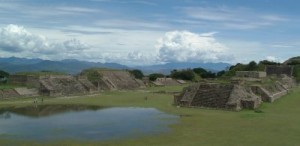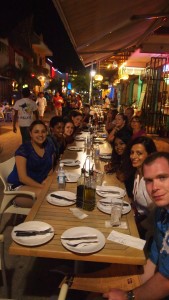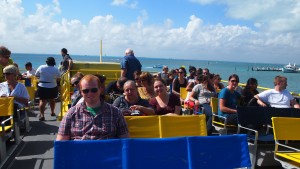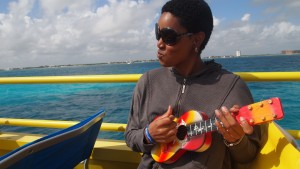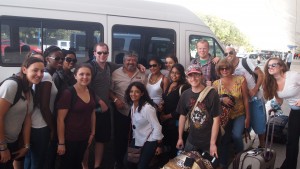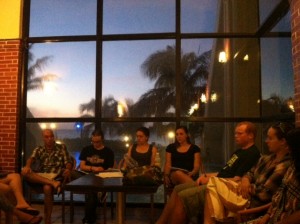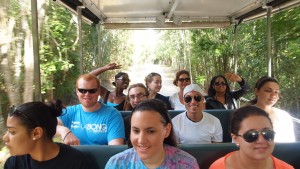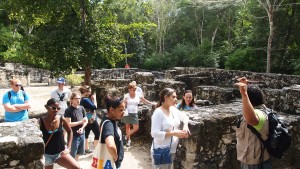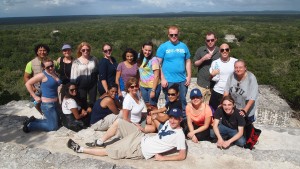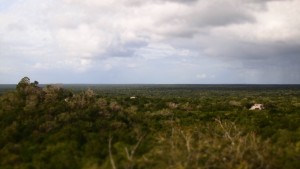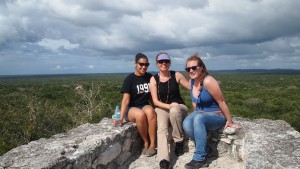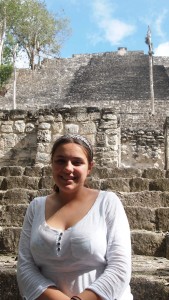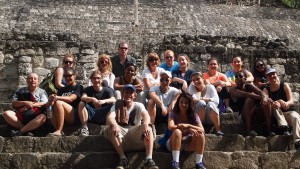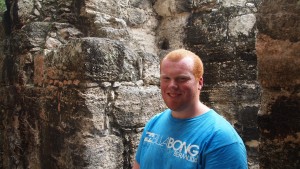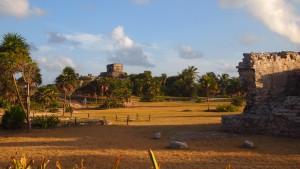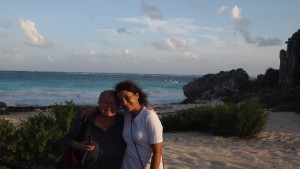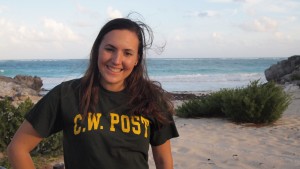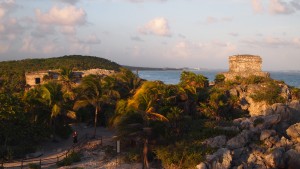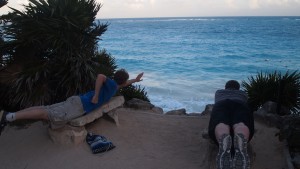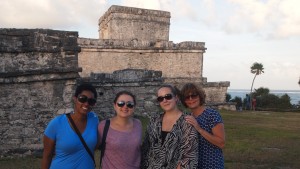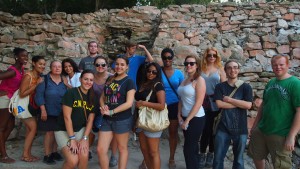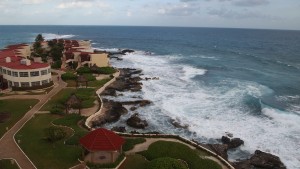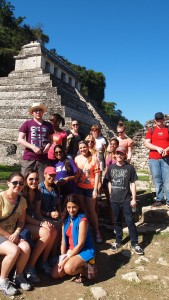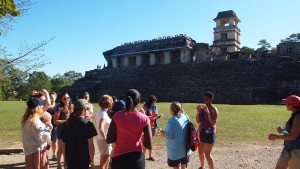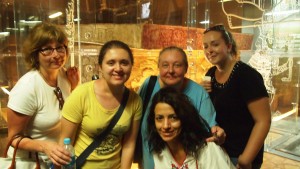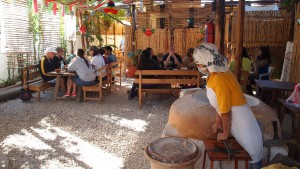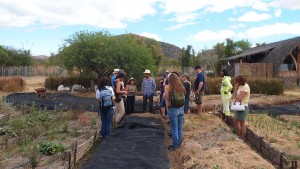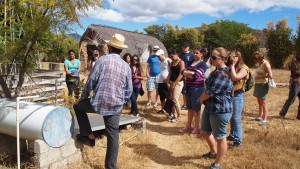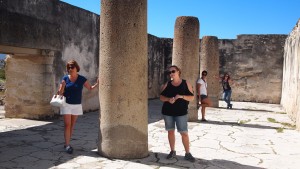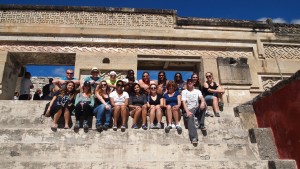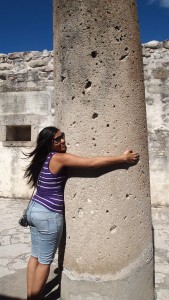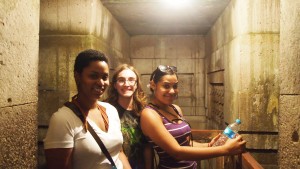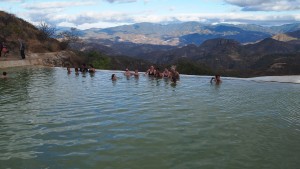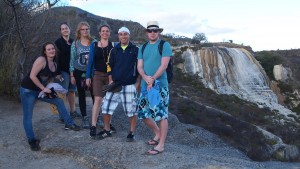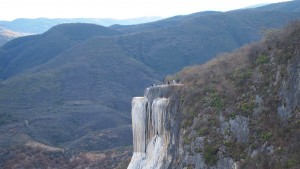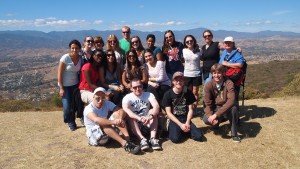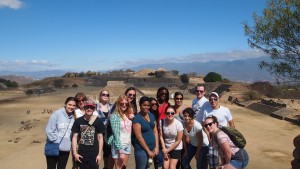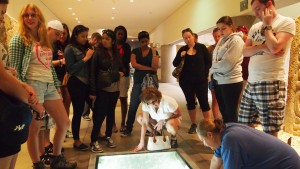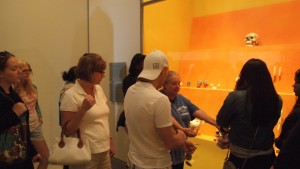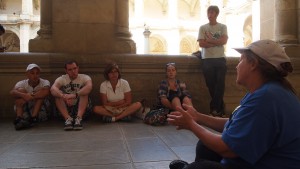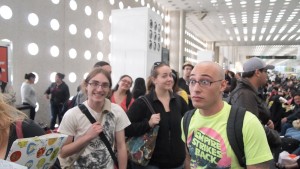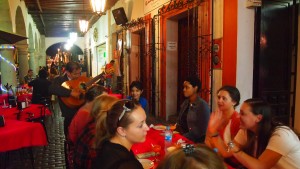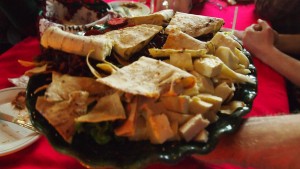Sociology Travel Course to Mexico – Winter 2013 (Overview below, scroll down for student blog posts and an archive of the original blog posts I made as the course took place).
Professors Rogers-Brown and Ferraro are leading a Winter travel course to Southern Mexico: January 4-14, 2013. Below is information about the course. All information is subject to change. Please email one of the instructors for more information and check back for updates.
Course: Soc/Anthro 35 or Soc 98. Also available for Honors credit.
Global Cultures: The Integration of World Community: A Field Based Course in Southern Mexico
Timeframe: January 4-14, 2013 (Credit for a winter course)
Course description:
This course examines the cultural and social connections of one selected area (Mexico) to the larger international community. It first describes the indigenous cultural and social features of the selected area and then forces of social change. This course will expose students to various indigenous cultures and people of southern Mexico where the ancestral tradition of the Oaxacans and Mayan civilizations exhibit the strongest cultural resilience today.
Objectives:
- Students will learn about issues and struggles of indigenous people in southern Mexico, their rich history of social change, and policies that have affected these populations.
- Students will meet representatives of NGOs and develop firsthand knowledge of indigenous cultural practices, resistance movements (such as farmer’s rights, biodiversity, autonomous indigenous rights, and women’s rights), environmental concerns, and poverty.
- Students will apply knowledge of sociological and anthropological theories of development and globalization to development programs in southern Mexico.
- Through exploration of the Biosfera Calkmul and conversations with civil organizations, students will develop a critical analysis of environmental concerns in the biodiverse landscapes of southern Mexico, particularly about land rights, water issues, animal protection, and preservation of biodiversity.
- Students will develop an understanding of the cultural and social mechanisms leading to the rise of complexity, state and great civilization in southern Mexico.
- Through archaeological sites exploration, students will appreciate the magnitude of the impact of such complexity on the expression of material culture.
- Students will demonstrate an understanding of the connections between past and present, as reflected today in strong resilience of cultural patterns and customs today.
Itinerary
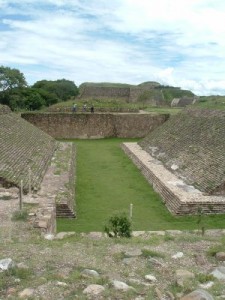 Day 1: Jan 4: Aeromexico Flight: JFK to Oaxaca (1.5 hour layover in Mexico City). Hotel–TBD, it will be near the zocalo and center of town.
Day 1: Jan 4: Aeromexico Flight: JFK to Oaxaca (1.5 hour layover in Mexico City). Hotel–TBD, it will be near the zocalo and center of town.
Day 2: Jan 5: Oaxaca City: Pochote Market, Monte Alban, and local artisan community.
Day 3: Jan 6: Mitla and Hierve el Agua.
Day 4: Jan 7: Tierra del Sol (a local NGO farm on the outskirts of Oaxaca city)
Day 5: Jan 8: morning bus to Palenque, Chiapas
Day 6: Jan 9: Palenque ruins. Hotel: Chan Kan Resort
Day 7: Jan 10: bus to Campeche and Reserva de la Biosfera Calkmul. Check in to the Chicanna Ecovillage Resort for two night stay in Xpujil.
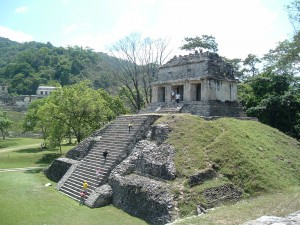 Day 8: Jan 11: explore Reserva de la Biosfera Calakmul with tour guide.
Day 8: Jan 11: explore Reserva de la Biosfera Calakmul with tour guide.
Day 9: Jan 12: Tulum ruins in the morning and later leave for Cancun to go to Isla Mujeres
Hotel: Avalon Reef Club (2 nights)
Day 10: Jan 13: Isla Mujeres
Day 11: Jan 14: ferry back to Cancun and airport. Non-stop flight to JFK.
—————————————————————————————
January 30, 2013
Written by Rita Iosefson about her experience as a student on this trip.
I’ve been struggling for days deciding how to begin writing about such a breathtaking trip! I still don’t know how to properly word what has been simmering in my mind. When we got to the airport on the 4th, I remember everyone was reading their course readers and keeping to themselves. Oh how that changed in a mere 10 days.
Oaxaca was definitely my favorite part of the course in Mexico. I could see myself exploring the open-air markets and the history of the region daily. I felt that I was truly immersed in the culture, and I adapted to the Oaxacan customs and traditions rather quickly. Let’s just remember how I tried “chapulinas,” “tuna” fruit ice cream, and countless sips of mezcal.
It was not just in Oaxaca where I got the most out of this course. Waking up every morning in Palenque, Calukmul, and Isla Mujeres, I was excited about the full itinerary for the day. Exploring the different cultures and climates was what was most exhilarating. My experience in Mexico was filled with a little culture shock and a lot of “quick assimilation.”
The Mayan Ruins were sights unlike anything I have ever seen. I’ve been to the slippery Parthenon and I’ve walked through the Forbidden City, but there was so much history all bundled into these amazing and huge structures, right below the US, almost in our backyard! Palenque and Calukmul were my favorites of the ruins, and I still can’t believe I hiked up those pyramids.
Every night, my roommate (and best friend) Lindsay and I would participate in our daily “reflection.” We’d get ready for bed and discuss the day’s happenings and how we felt about everything we had just seen. It was almost like we were writing a reflection journal every night!
The trip for me was not about getting an A; the trip was about having the experience of a lifetime. I would have never thought I would hike a Zapotecan ruin, go to a market and go dancing all in the same day. There are things I never would have done if I had not taken the chance and sign those papers to join this great class to Southern Mexico.
Also, I have to say, the professors without a doubt made this course the best experience. Jennifer and Chantal viewed us all as colleagues, rather than students. We were treated as adults, and we all took the responsibility of making the course enjoyable for everyone. I came home with 17 new friends, three of which I see in my sociology class every other day! I cherish every memory we made together in Mexico. Uno mas!
———————————————————————————————————————————-
January 19, 2013
Written by Michelle Dindiyal after returning from our travel course:
I am a 20 year old Junior at LIU Post in NY, and as soon as I heard about the Mexico study abroad travel course (SOC 35), I convinced my dad that this is a program that I cannot miss. This is my second study abroad program and I am absolutely convinced that studying abroad not only liberates the mind from the prism of American chauvinism, but also makes one appreciate the diversity and beauty of the American culture. The exposure and experiences I garnered from studying just ten days in Mexico will allow me to grow as an independent thinker and educate others.
My morals, customs, ethics, habits, and ideologies are all reinforced by American culture. In America, I generally spend my free time shopping, playing video games, going to clubs and hanging out with friends. Traveling to Mexico, a third world country, aroused my appetite that it is time for me to step out of my comfort zone and into a state of unfamiliarity.
Studying in Mexico gave me an opportunity to explore not only a foreign land but myself as a human being. It not only broadened my horizons, but it also allowed me to reevaluate the way I see the world. This is crucial for a better understanding of the under privileged in the world. What is normal? What is respect? What is beauty? What is art? What is justice? What is history? What is rational? And most of all what is it to be a Human Being? These are some of the thoughts that will make have a more objective view on life will allow me to have a better appreciation for life.
Mexico is the ideal location to study abroad. It is the southern neighbor of the United States. Its deep history, sophisticated culture, exotic pyramids, indigenous cultures and most importantly delicious food, are wonderful to experience and learn about. The markets and pyramids that I saw in Oaxaca are a prime example. Going to college it is not just about learning out of the book, but also learning through experiences. Studying in Mexico is one of the few learning experiences for students of Long Island University, and my experiences in the Winter of 2013 is written with indelible ink and will stay with me for the rest of my life. I am now a firm believer that real-life experiences not only broaden the mind, but also allow you to experience other ways of living and thinking that will enrich you as a human being.
———————————————————————————————————————
January 15, 2013
The LIU Adventure Team (AKA Soc 35 travel course) has made it home! Please check back to this page for blogs from students about their experiences. It was wonderful to work with Prof Ferraro and Shawn Tallant. I learned a lot from them and the students.
———————————————————————————————————————-
January 14, 2013
We have one hour before we take taxis to the ferry and then off to the aiport. Yesterday the students presented their papers, which turned out to be an affirming recognition of not only the success of the trip, but also the importance of a trip like this. We grouped the students by theme and treated the presentations like a conference. During the morning session, we had panels on archaeology (primarily Mayan design), conservation, and food & water. In the afternoon, students presented on social issues (such as family structure) and migration. And in between– most of us went snorkeling. Others explored the island and saw the Isla Mujeres ruins. I went snorkeling for the first time and loved it.
Everyone is expressing a positive feeling about this trip, but potentially too much so. Many of us don’t want to come home!
——————————————————————————————————————-
January 12, 2013
We finally made it to Isla Mujeres, a small fishing island off of Cancun. At breakfast this morning several of us discussed the changing landscape from Oaxaca to Campeche to Cancun. We have seen globalization in many forms– imported inexpensive products in the local markets, indigenous artisan crafts for sale to tourists, ecotourist sites, and finally the large tourist infrastructure of Cancun. Cancun stands in stark contrast to Oaxaca, and that contrast illustrates some of the issues we discuss in this class. In today’s post I will discuss our two recent adventures in the Calakmul Biosphere and the ruins at Tulum.
Shawn’s friend, Luis, is a guide at Calakmul and founder of Heroes Verdes. He is only 19 years old, but he expertly pointed out wildlife and explained the archeological history of Calakmul. The view from the tops of the Mayan pyramids were breathtaking:
———————————–
Tulum:
I honestly thought we showed up in a Miami beach community when we arrived at Tulum. Most people were in flip flops, not hiking shoes, and bathing suits. This was unlike any set of ruins I saw before. If you were to live in a Mayan community, would you choose the forest or the beach?
Double superman plank at Tulum:
And just to make everyone jealous in cold New York– here is a picture of the view from my hotel room:
We are in a beautiful hotel and the students have a fantastic spot to finish up class assignments and plan their presentations and papers.
———————————————————————————————————————
January 10, 2013
On the edge of the Calakmul Biosphere, this group of students is waking up to a beautiful overcast day with new bird sounds and in the distance– monkeys, jaguars, and more. We organized this trip to respond to the interests of each individual student. After almost a week, they are now coming to Chantal and I with ideas for their final papers and presentations. However, a few are waiting for the biosphere experience and all it has to offer. Several students are using this as an opportunity to learn about ethnographic fieldwork and consider research ideas for graduate school.
Yesterday we explored the ruins in Palenque. These Mayan ruins feature towering pyramids that show a once-thriving city within the rainforest.
Off to the Biosphere at Calakmul!
———————————————————————————————————————-
January 9, 2013
Yesterday we watched the landscape change from a dry (mostly brown) landscape to a rich biodiverse forest in Chiapas. We are now within a mile from the Palenque ruins and I write while the group refreshes over breakfast. We all wish we could stay an extra day at this hotel– (note to self for next time). Yesterday was a long drive, over 14 hours on the bus because of construction and many necessary food and bathroom breaks. We rerouted at the last minute for this longer route because the direct 8-10 hour trip to Palenque is much too curvy for our group. It may have taken longer, but at least our stomachs are in tact and we are safe. The closest airport is over an hour away and there are no direct flights between Oaxaca and Palenque. But we have a fantastic group of students who have taken on every challenge with a smile. The professors are very grateful for that. I am excited to see the students faces when we walk out of the trees and into the Palenque ruins to see The Temple of the Inscription– and hear the monkeys in the background.
——————————————————————————————————————
January 8, 2013
Yesterday was my day to give the students the “Jennifer Brown research experience”– all corn, NAFTA, farms, and farmers (and dry compost toilets for fun). We started the day at Itanoni Restaurante. Besides the fabulous experience of watching our food prepared on a comal and the delicous use of herba buena leaves (picked from the tree by our table), Itanoni only uses non-GMO organic corn sourced from about 5 local farmers. This helps the local farmers sustain their organic and indigenous practices.
After breakfast we went to one of the highlights of the trip, a self-sustaining teaching farm that focuses on permaculture practices: Tierra del Sol. Peter and Margarita showed us around the farm while discussing the impacts of free trade in Oaxaca, impacts of GMOs on diversity, NAFTA and migration, and their thoughtful farming practices such as raise beds, composting, rotating the hens, heating the water through the sun, and composting toilets.
It’s almost 6am and we are 10 minutes from driving to Palenque. This will be a full day in the car. Wish us luck!
——————————————————————————————————————
January 7, 2013
We started the day in the Tlacalula market with a modified scavenger hunt for traditional Oaxacan items. This market helped us illustrate connections between trade, migration, and the local and global. I discovered a beautiful variety of seeds (including an indigneous red corn) and a banana I’d never seen before.
After the market we went to the Mitla ruins. It’s a fascinating site because everyone can see how the Catholic church took stone and structure from the ruins to build a church at the site. This church is still used today. This site also has two tombs to enter and a Pilar of Life– it is said that if you hug it you can tell how long you have to live.
After this wonderful educational experience we took a break at the Hierve el Agua mineral springs.
——————————————————————————————————————-
January 6, 2013
From Zapotec pyramids to blue corn tortillas, the students have already explored several facets of Oaxacan culture, indigenous histories, and globalization. Below you can see the entire group atop Monte Alban, with a great view of Oaxaca behind us.
And with the view of Monte Alban:
Chantal Ferraro, professor of Anthropology, captivated the students in the museum at Monte Alban.
After Monte Alban, we went to the organic Pochote market for lunch. The students were instructed to ask the vendors/producers/farmers questions about their food– such as where the produce is grown, why they use only organics (and what that means)– which later helped us have an informed discussion about the impacts of free trade and globalization in Oaxaca. For me it was fun to watch the students learn directly from some of the same people I interviewed for my new research project. I’ve known one of the producers for 6 years and he was shocked when I showed up with 16 people who wanted to know more about his products. He was grinning ear-to-ear.
Today we are off to the Mitla ruins and the mineral springs at Hierve el Agua.
———————————————————————————————————————
January 5, 2013
Hello from Oaxaca! Despite some confusion at the Mexico City airport, we successfully made it to Oaxaca.
We learned that you have to be patient at the airport and go with the flow… but we got to know each other more.
Today we are off to Monte Alban where Chantal Ferraro will lead discussion of archeological history of Oaxaca. Afterwards we will head to the Pochote organic market where the students will practice their sociological questions about local foods, organics, and cooperative production and selling.
———————————————————————————————————————
January 1, 2013
I’ll be blogging here with updates from my LIU Post Sociology 35 Winter travel course to Mexico with 16 students. Check back for updates! I will post whenever internet access allows. We leave Friday morning, Jan 4 and arrive in Oaxaca late afternoon.
